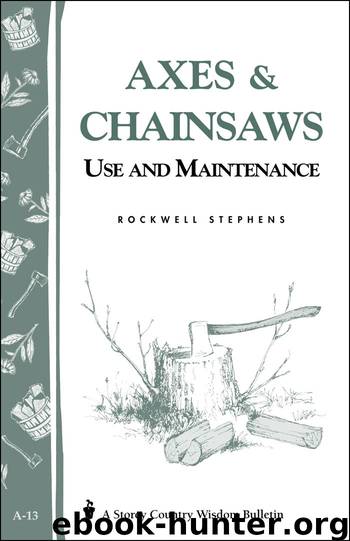Axes & Chainsaws by Rockwell Stephens

Author:Rockwell Stephens
Language: eng
Format: epub
Publisher: Storey Publishing, LLC
Published: 1977-03-25T16:00:00+00:00
Maintenance
If we were not accustomed to accept as commonplace the combination of such engineering and metallurigal wizardry, the chain saw would be something for a museum of technology. On the contrary, it is an everyday tool that will function with great reliability and efficiency given no more than ordinary, commonsense care.
Maintenance starts with lubrication. The two-cycle engine runs on a mixture of gasoline and oil, and this means specially-compounded two-cycle oil—not ordinary engine oil—which several manufacturers supply in convenient six-packs of 6-ounce cans. The standard mixture is six ounces to two gallons of gasoline, but follow the manufacturer’s recommendation for your saw.
If this oil is not available on occasion, two-cycle oil in SAE 40 weight can be used in the proportion of six ounces to one gallon of gasoline. This oil (and it must be labeled “two-cycle oil”) is usually available in quarts.
Special oil, labeled “bar and chain oil,” lubricates chain, bar and sprocket, and is available under various brand names. If this can’t be located, regular SAE non-addative motor oil can be used at temperatures of 40°F or more, SAE 20 at lower temperatures.
The makers of some two-cycle engines—such as outboards and tractors—suggest a lighter oil or more of it in your gasoline during the breaking-in period—but this is not the case for most chain saws. It is good practice, though, to use extra oil on the bar and chain when starting up a new saw. Many saws have a auxiliary button you can use to pump more oil on the chain than the automatic pump provides.
The bar oil and fuel tank capacities of all chain saws are proportioned so that they both run low at the same time. When out of gas, fill up with bar oil too.
I mix up gas five gallons at a time, but lugging this big can around when working in the woods is such a chore that I load up a gallon plastic jug for the gas and a similar quart container for bar oil—handier to carry and easier to pour without spilling.
Safety and common sense both suggest due caution when filling the gas tank. Let the engine cool a bit first to avoid the chance of fire or explosion. And as for smoking and matches . . . . .!
Maintenance, aside from keeping the chain sharp, is mostly a matter of keeping things clean. The first time I removed the clutch cover and bar and realized how much oil-soaked sawdust and dirt had accumulated, I wondered how the saw could go on working, packed up as it was.
After cleaning out this gurry, scrape out the groove in the bar. The dealer probably has given you a tool for this—a thin blade hooked on one end—as well as a combination wrench and screwdriver to handle clutch cover nuts and adjust the chain tension. The scraper should move freely in the bar slot. If it binds at any point the bar has been pinched, probably in the course of felling a tree, when this sometimes can happen.
Download
This site does not store any files on its server. We only index and link to content provided by other sites. Please contact the content providers to delete copyright contents if any and email us, we'll remove relevant links or contents immediately.
Audition by Ryu Murakami(4107)
The Body: A Guide for Occupants by Bill Bryson(3815)
Adulting by Kelly Williams Brown(3681)
Housekeeping by Marilynne Robinson(3420)
Zero Waste Home by Bea Johnson(3297)
Be in a Treehouse by Pete Nelson(3234)
Seriously... I'm Kidding by Ellen DeGeneres(3106)
Better Homes and Gardens New Cookbook by Better Homes & Gardens(2962)
Barkskins by Annie Proulx(2885)
The Healing Self by Deepak Chopra(2802)
Hedgerow by John Wright(2781)
The Life-Changing Magic Of Tidying Up- The Japanese Art Of Decluttering And Organizing (v5.0) by Marie Kondo(2751)
Spark Joy by Marie Kondo(2686)
The Genius of Japanese Carpentry by Azby Brown(2615)
The Cellar by Natasha Preston(2604)
Work Clean by Dan Charnas(2564)
120 Days of Sodom by Marquis de Sade(2446)
The Book of Numbers by Peter Bentley(2411)
A Monk's Guide to a Clean House and Mind by Shoukei Matsumoto(2409)
